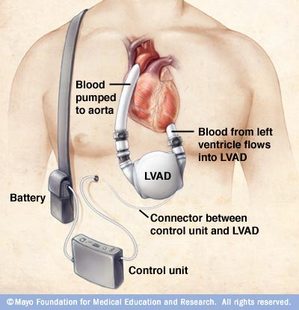U-M cardio center performs 500th heart device implant surgery
During his 40-year career as a teacher, Darol Straub, 65, of Ann Arbor, would bring salvaged computer parts to his high school students for them to experiment with.
As a retiree, Straub carries the memories of his students close to his heart — and he now has a high-tech piece of equipment to accompany them.
Straub is the recent recipient of the 500th heart device implant surgery by the University of Michigan Cardiovascular Center in Ann Arbor.

A diagram of a left ventricular assist device.
Courtesy of the Mayo Foundation for Medical Education and Research
The first hospital in the state to implant heart-assist devices for patients awaiting transplant was at the University of Michigan. The cardiovascular center has been performing these surgeries since 1996.
Straub worked at Monroe High School and part-time at Monroe Community College for the majority of his education career as a math, physics and computer science teacher.
“I’ve had over 7,000 students and I don’t think there was one I didn’t like,” Straub said.
The students learned to build their own computers from bits and pieces left over from Ann Arbor research and development firms at which Straub worked, he said.
Some of them eventually went on to work at large technology firms like IBM, Straub said.
At home and recovering after five weeks in the hospital, Straub said he’s slowly beginning to walk and exercise as a part of his recovery.
“For patients in severe chronic or acute heart failure, heart-assisting technology can offer a gateway to better long-term quality of life,” said Dr. Keith Aaronson, medical director of the heart transplant program and Center for Circulatory Support at the U-M Cardiovascular Center, in a news release.
Amy Biolchini covers Washtenaw County, health and environmental issues for AnnArbor.com. Reach her at (734) 623-2552, amybiolchini@annarbor.com or on Twitter.


Comments
Shantell Kirkendoll
Tue, Jun 5, 2012 : 3:49 p.m.
RRinAA The U-M has worked with several heart device manufacturers including Heartware, Ann Arbor-based Terumo, Thoratec and Syncardia. Offering a variety means we are able to meet patients' specific needs. U-M researchers and physicians have provided leadership in the clinical investigation of most of the implantable circulatory support devices in use today. So as new devices become available, both in clinical trials and after federal approval, our patients are often the first to benefit from their use. LVADS are used as bridge to transplant but the tables are turning and we're seeing more patients using LVADs as a permanent alternative to transplantation. What's called destination therapy. Shantell M. Kirkendoll University of Michigan Health System Public Relations
Shantell Kirkendoll
Tue, Jun 5, 2012 : 3 p.m.
Fairfield, The U-M Center for Circulatory Support has a one-year survival rate of 97.4 percent, which far exceeds national trends. Of course over the years many of the patients have gone on to get heart transplants, but in the meantime a heart device implanted at the U-M helped them regain some normalcy in their daily lives. There are about 110 U-M patients currently on a heart device. Shantell M. Kirkendoll University of Michigan Health System Public Relations
RRinAA
Sun, Jun 3, 2012 : 3:34 p.m.
More information, please: Has UM focused on one LVAD manufacturer, and if so, is it Terumo's device? Are these devices being used a more than a bridge to transplant? Great to hear of the success, and all the best to Mr. Straub!
fairfield
Sun, Jun 3, 2012 : 12:06 p.m.
500 heart-device implants. Impressive, if you assume all were successful. Do you have any figures as to how many patients died during the operation or just after being discharged, how many survived more than six months? That's what patients are interested in knowing.